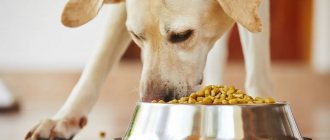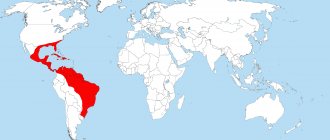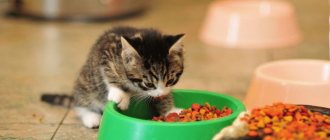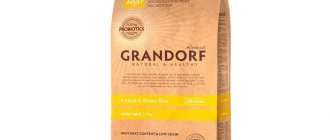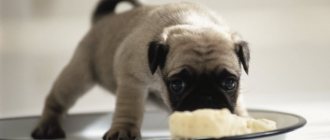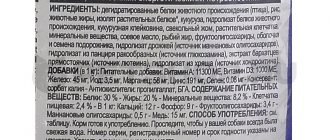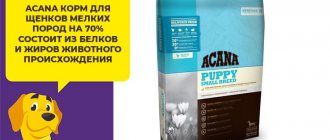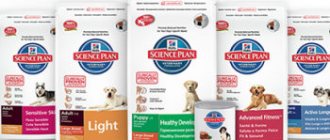Switching dogs to dry food has benefits for both owners and pets. There is no need to waste time preparing food; you can quickly feed your pet, while it receives all the vitamins and microelements necessary for its body. But it should be noted that the transition to dry food should be gradual, and if we are talking about puppies, then this issue must be approached more scrupulously. At first, babies need to soak their food. It is important for dog owners to know how to do this correctly.
Rules for introducing complementary foods
From birth, puppies eat their mother's milk, but as they grow older, they become interested in other foods. First of all, they get to know what their mother eats and even taste the food. But if she eats specialized dry food for dogs, then the puppies are unlikely to be able to bite through such a delicacy, because the babies’ teeth are not yet strong enough.
Complementary foods begin to be introduced in the second month of the puppies' life. Some breeders prefer to feed their pets natural food, so they use meat broth, boiled minced meat, fermented milk products and milk as complementary foods.
A fairly large percentage of breeders believe that commercial dog food is an excellent choice because it provides the animals with all the necessary nutrients.
Industrial feeds are divided into several classes:
- holistic;
- economy;
- premium;
- super premium.
The last option would be a good choice for pets. Its rich composition replaces a complete diet, therefore, eating such food, animals grow and develop according to the norms. As a rule, food for puppies comes in the form of pates, pastes and canned food, consisting of small pieces of soft treats with sauce or jelly.
There are also dry foods for babies, but it is recommended to give them only after 4 months. The appearance of such food differs from treats for adult dogs in the size and density of the granules. The food also has a shiny surface due to its high fat and calorie content.
At what age can you start feeding puppies complementary foods?
When answering the question of when you can feed puppies, veterinarians and dog experts are of the opinion that it is best to start at three weeks. Undoubtedly, mother's milk is the best food for still immature newborn puppies, but after a few weeks they are ready to get acquainted with the world around them. The ideal age to start feeding small puppies is from three weeks, or even two.
Proper diet is very important for a puppy
In this matter, it is extremely important not to rush or be late. In the first case, the mother will reduce the amount of breast milk she produces, causing the entire litter to be malnourished. In the second case, delayed complementary feeding entails a slowdown in the growth and development of the body; such pets often grow up sick and weak.
Is it necessary to soak the food?
Despite manufacturers' recommendations, breeders claim that dry puppy food needs to be soaked, and there are several reasons for this:
- hard granules can damage the baby’s delicate gums;
- baby teeth are not strong enough to chew such hard food;
- the stomach of a small pet does not have the necessary enzymes to digest dry granules, which can cause disruption of the gastrointestinal tract;
- Consumption of dry food during the teething stage can lead to crooked teeth.
There is an opinion among dog owners that chewing dry food helps strengthen and clean teeth, but this is a misconception. To remove plaque, it is necessary to resort to regular brushing of the teeth with a brush, and to strengthen it, it is recommended to give the puppy special toys. It should also be taken into account that as a result of damage to the gums by hard granules, the baby will experience discomfort at every meal, which is why he will not be able to eat the prescribed portion or will refuse to eat at all.
Soaked food can be given to puppies over 1 month of age. This can be either a separate dish or an addition to soup, porridge and other food. It is recommended to feed dogs soaked kibble until their baby teeth come in. For each breed, this period lasts differently, usually lasting no more than six months. Therefore, at the 7th month of life, you can add dry granules to your pet’s food, but their amount should not exceed 25% of the serving.
Gradually, the ratio of solid and soaked food increases; at about the age of 1 year, the dog will be completely switched to dry food.
Reviews
Elena, Smolensk
“I believe that food should be diluted only as long as the puppy has milk teeth. We ate natural food for up to six months, then switched to dry food. Initially, I soaked the food until it was mushy, then I started feeding the dog semi-soaked food. A week later we switched completely to dry. At first, our Bim didn’t understand how to eat it. Now she eats dry food with pleasure!”
Inna, Tula
“My Chappie turned 9 months old yesterday. We bought the puppy very young, he was only 1.5 months old. We immediately decided to feed him dry food. Fill with water for 15-20 minutes. At the command “Eat,” the bowl is licked within a minute. I've heard that puppies can't control their water intake on their own. Thanks to this method, I know for sure that my pet consumes enough water.”
Rules for soaking food
There are several ways to soak food, using different liquids. The main condition is that the liquid must be warm or at least room temperature. Quite often they use boiled water at a temperature of 40-50 degrees, which allows you to quickly steam the food. At the same time, its smell intensifies, becoming more attractive to the puppy.
It is recommended to use a metal bowl to soak the food, as it holds the temperature better. The granules filled with warm liquid are covered with a lid or plate and left for about 20-30 minutes. After the food has increased in volume and becomes soft, you need to drain off the excess liquid and mash with a fork, turning it into a paste. But you can also feed your baby softened food without additional grinding.
In addition to water, you can use warm chicken or beef broth to steam dry food.
In this case, you don’t have to remove the remaining liquid after softening the granules; the puppy will enjoy it with pleasure. It is important to remember that the broth should be low-fat, because the baby’s stomach will not be able to absorb it, which will cause indigestion. To soften dry dog food, milk is often used, but it is important to note that it should not be from cows. Breeders recommend the following options:
- powdered milk - especially if the puppy has a poor appetite;
- an industrial substitute for bitch milk, the composition of which is as close as possible to natural;
- diluted goat milk in a 1:1 ratio.
Dry granules in milk will take longer to soften. The prepared amount of food should be enough for one meal, because food soaked in milk cannot be stored; a new portion must be prepared each time. In rare cases, kefir is used to soak food, as it is not suitable for all dogs. When choosing this option, it is important to consider some features of preparing food for your baby:
- You can only use natural kefir with a low fat content;
- the temperature of kefir should not exceed 38 degrees, so it is better to heat it in a water bath;
- it will take at least 20 minutes to completely soften the granules;
- The prepared delicacy cannot be stored.
Soaking dry food in kefir is good for babies with dysbacteriosis. As a rule, this digestive disorder is observed in puppies that lived on the street or in rural areas. But it should be remembered that dysbiosis can begin as a result of stress associated with a change of place of residence.
If a puppy comes into your home and you notice he has indigestion, then it is recommended to feed him kefir for a while, but in small quantities.
Diet depending on age
1 month
What is the best way to treat a one-month-old baby? At the initial stage, the puppy's gastrointestinal tract is adapted to digest only mother's milk and some soft food. It is better not to overload the baby’s body and give him cow’s milk , if it is not possible to eat mother’s milk, milk with cream and porridge (buckwheat or oatmeal).
Never give puppies hard beef bones : they may not be digested and may end up in the intestines and scratch or even tear them.
Also, it depends on the breed. There are dogs that genetically have a low appetite (dachshunds, spaniels), so there is no need to worry if the puppy does not eat anything - he simply does not want to.
2
At 2 months, the puppy’s eyes are already appearing and teeth are beginning to form. It is recommended to give a two-month-old animal a small amount of cottage cheese, feta cheese, or hard cheeses, boiled vegetables, cabbage, and fresh minced meat .
3
A three-month-old puppy has already formed a chewing reflex, which means it can be fed with solid meat . At 3 months, it is better to give meat raw, since the body is accustomed to this type of protein.
If you give boiled meat, the puppy will eat it, but problems may arise with absorption, since the meat is partially digested, and the amount of enzymes and gastric juice will be released as if it were raw. This may lead to irritation of the stomach walls or even a gag reflex.
4
By 4 months it’s time to sharpen your teeth. You can feed your pet bones , first breaking large pieces in half so that they do not become across the throat.
You can give chicken feet, but you need to cut off their claws to eliminate the chance of injury to the esophagus.
Some pet stores sell mineral bones , these are also available.
5
At 5 months, the dog can already digest large portions of food; sometimes you can even pamper him with fried meat (in moderation).
Remember that a dog is a predator. Every dog needs to compete and receive rewards, so reward your dog with his favorite treats for good deeds or obedient behavior. You can also use treats to train your pet and teach it commands.
From 6 months to a year
You can include porridge, bread, potatoes (even raw) . It will provide your pet with energy and ease the gastrointestinal tract, thanks to its fiber and microelements content. You can add porridge as the bulk of the dish, some seasonings, and a little salt to improve the taste.
Dogs have very individual tastes. Try to understand what exactly your ward likes. Some dogs like very unexpected foods: for example, pork spleen, lamb heart, tripe. There are also those who eat sauerkraut (although eating salty foods is not recommended for animals) or boiled potatoes.
Chicken eggs are a favorite treat for dogs. They are rich in healthy polyunsaturated fats and protein, which is the standard for all living organisms, since it contains a complete amino acid profile and is absorbed almost instantly. The maximum amount that will not harm your pet is 3-4 whole eggs per week .
Prohibitions and recommendations
In order not to harm the puppy’s growing body, you must follow several recommendations.
- When starting to introduce dog food into your diet, at first you should use only water for soaking. After 1-2 months, you can try to soften the food in low-fat broth and milk, but if the baby experiences indigestion, then it is better to abandon this idea.
- You can use only warm water, the temperature of which does not exceed 40 degrees. When dry granules are steamed in boiling water, some beneficial substances are simply destroyed, therefore, the food will be less healthy and nutritious.
- After feeding the puppy, leftover food should be put in the refrigerator, but it can be stored for no more than 12 hours. Before the next feeding, the food needs to be warmed up a little. It should be noted that such manipulations can only be carried out with food soaked in water, and in other cases the remains must be thrown away.
- To steam the food, you must use purified water, and it is also important to remember to wash the bowl before and after preparing food.
Dog owners should remember that water should always be freely available to their pet, as a lack of fluid may disrupt the pet’s digestive process.
For information on how to properly soak food, see below.
Can dry food for adult dogs be soaked in water? Softening the granules with ordinary water does not affect their beneficial properties and nutritional value. But most animals consume it with pleasure in its pure form.
Some dog breeders believe that dry food granules can scratch the delicate surface of the pet's stomach mucosa. Whether this is true or a myth, in which cases wetting can be used and with what, we will examine in detail in this article.
What and how to give puppies after one month of age
The schedule and mode of feeding your pet directly depends on its age. At different stages of growth and development, a dog’s body needs certain substances. This must be taken into account when planning your diet.
During the period of 1-2 months, the puppy experiences an acute need for calcium. This macronutrient is necessary for the body for proper skeletal development. That is why the daily diet should consist of approximately 40-50% dairy products. You can introduce kefir, sour cream or cottage cheese into your diet.
Note! It is better not to give fruit yoghurts and other dairy products that contain dyes and flavor enhancers.
In addition to dairy products, your pet also needs fresh meat. Per day, as a percentage, it should be at least 40%. It is recommended to give preference to boiled poultry or raw beef. You should definitely give up fatty pork. The remaining 10-20% consists of fresh vegetables and fruits.
Water consumption rate for dogs
A dog is a predator. They require about 80% liquid from their daily diet. This is explained by the chemical composition of the meat that their relatives eat in the wild.
Dry granules contain no more than 10% moisture. It is very important to ensure that the animal has free access to drinking water. To do this, it is not necessary to mix it with food; it is enough to always have a bowl of clean liquid nearby. The dog itself will drink the required amount for normal digestion.
The volume of fluid consumed normally is calculated as follows:
- minimum: 20 mg per 1 kg of dog weight;
- maximum: 70 mg per 1 kg of weight.
It turns out that an animal weighing 20 kg needs to drink 400 – 1400 mg of liquid per day. The variation in volume depends on several factors:
- in hot weather the body requires more fluids;
- active individuals need more than passive counterparts;
- individual characteristics of the organism of individual animals.
If the pet is fed natural food, then some of the moisture enters the body along with the food. In winter, the need is significantly reduced. But if the dog is on a dry diet, it must receive additional water.
Do dry food for adult dogs need to be soaked?
Feeding dry food is attractive because it does not require much effort in preparing it. It is enough to pour the granules into one bowl and pour clean water into the second. Whether or not to soak dry dog food is determined individually.
- The animal is unable to chew pellets. Sometimes complications occur in the oral cavity: tooth extraction, gum disease. Then it is better to soften the food so as not to aggravate the situation. And you should definitely show your pet to a veterinarian to remove the obstacle.
- The dog does not want to accept dry food at all. Under the influence of water, it will become more fragrant and attractive to the dog. With the familiar structure of the product, he will quickly get used to the new smell and taste. Later, the pet will begin to eat unsoaked food.
- The animal prefers pellets soaked in liquid. And animals have their own individual preferences. Nothing bad will happen if you feed him softened granules constantly.
- When puppies are weaned from their mother's milk. Soft food is more suitable for babies. Or during the period when their teeth change and a painful sensation appears in the gums. You can control the hardness of crackers by reducing the time they remain in water. So, gradually the dog will switch to full-fledged dry food.
- As recommended by a veterinarian. A last resort in case of pathological conditions.
You should be concerned if your dog vomits the contents of its stomach 15–20 minutes after eating. Vomit with intact granules indicates that the body does not receive the required amount of moisture. This means that the pet does not drink after eating, disrupting the digestion process.
If the dog quickly swallows the food and still feels hungry, it is better to wet it with water first. Swollen granules will quickly create a feeling of fullness.
After introducing soaked food into your diet, follow the rules for brushing your teeth. You can buy functional treats for these purposes.
Tips for small breed dog owners
Each breed has specific feeding recommendations. Most small breed dogs are predisposed to oral diseases such as caries, stomatitis, gingivitis, periodontal disease, and enamel dysplasia.
Among the breeds at risk are small poodles, spaniels, lap dogs, dachshunds, Pekingese, Yorkshire terriers and others.
The nutrition of such puppies must be approached with extreme caution. Starting from one month of age, the dog is gradually introduced to dry food diluted in water in a ratio of 3:1. After two and a half months, you can switch to a regular diet.
It is important to select high-quality dry food of at least premium class. The following brands are recommended for owners of these breeds: Royal Canin, Orijen, Akana, Bozita, Monge and Brit Kare.
Chihuahuas have an increased tendency to allergies and digestive disorders. For lovers of this breed, it is better to choose super premium food. Breeders recommend Total, Bosch, Proplan. Guts.
As a rule, small breed dogs do not like dry food, so the food should be softened in warm water. Thanks to this, the food will be digested faster and the dog will not feel discomfort.
When is this not necessary?
Some dog breeders generally give dry food in a soaked form, although their pets enjoy eating it in its original form. They are usually driven by misconceptions:
- Many dogs greedily swallow food, and owners fear that the pet may choke. But soaking the granules does not solve the problem. To slow down the process of food absorption, you can put a toy in the bowl with the food that she will not swallow. The dog will be forced to constantly push away the interfering object with its muzzle, and this will slow down its food intake.
- There is an opinion that soaked food is healthier. Another baseless version. Water does not affect its usefulness in any way.
In which cases is it not necessary to add liquid:
- The animal readily eats the food and drinks plenty of water.
- He responds well to the signal to eat and feels great afterwards.
- There were no abnormalities in the gastrointestinal tract, the coat was shiny, the skin was healthy.
- There are no difficulties with chewing and swallowing: the teeth and oral cavity are without pathological changes.
If there are no difficulties with feeding, then you should not soak dry dog food with water. An animal may eat dry food without enthusiasm, but this does not mean that it is bad or requires softening. Many flavor and odor enhancers are added to cheap diets. The pet greedily swallows such baits.
Conscientious manufacturers do not resort to such tricks and produce a high-quality product without harmful additives. Therefore, the dog eats such food with less excitement.
It is believed that softened food is easier to digest. The process occurs under the influence of hydrochloric acid and special enzymes in the stomach. It doesn't matter if the granules are dry or wet.
How and with what can you soak dry granules?
Experts advise using clean water for soaking. It is important that the product does not lose its beneficial properties. It would be correct to do this:
- pour granules into a bowl;
- barely cover the food with water;
- wait until the liquid is absorbed into the product.
After these procedures, the dish is served to the pet. You can also soak dry dog food in broth. Animals are wary of any new product. They sniff, but when they smell a familiar smell, they absorb it with pleasure.
It is not recommended to use boiling water. The water temperature should not exceed 35–40 degrees. In hot water, food swells faster, but at the same time loses many useful substances.
A diet with a higher percentage of meat in its composition takes longer to soften. Cheap, grain-rich feeds absorb moisture faster, but the state of porridge granules will never be achieved.
For puppies, dry food is ground in a blender. To improve the taste, pour warm milk or kefir over it. In this case, be careful not to have any digestive problems. Do not leave leftover food at room temperature, otherwise it will turn sour.
Video: Is it possible to soak dry food for adult dogs with water?
Price and quality
When your pet becomes an adult, it will be possible to switch to cheaper food. But it is recommended to do this only if absolutely necessary. For puppies, feeding economy class dry food is completely unacceptable. To ensure that an adult dog does not have health problems, you need to invest as much as possible in the baby. Therefore, choose only super-premium brands, and even better, professional food. Consult your veterinarian and breeder, he will tell you which one is best to buy.
How long does food prepared this way last?
Manufacturers do not provide such an option for feeding their feed, so they do not indicate the shelf life for it in wet form. If the dry product can be poured in and left for a long time, then the moistened dog should eat it at one time.
You cannot prepare such food for future use. If the portion is not eaten, then it is better to get rid of the leftovers. In hot weather, wet food spoils quickly. Moreover, if you use other substances rather than pure water.
Eating spoiled food leads to intestinal upset and poisoning. You can put leftovers in the refrigerator for no more than 12 hours. Before serving, you should warm it up a little, but the consistency and taste of the product will differ from freshly prepared. Don't be surprised if your pet refuses it.
If you like the benefits of feeding a dry diet, experts do not recommend introducing your animal to soaked food. Otherwise there must be good reasons for this. Having decided to pamper your pet once, you may later face refusal of dry granules. Do not prevent your pet from enjoying crunchy “crackers” if he drinks them with a sufficient amount of water.
Does dry dog food need to be soaked? This question interests many owners who have previously switched their pets to drying. Conversations that solid food granules can injure the mucous surface of the gastrointestinal tract and provoke gastritis and even ulcers in dogs frighten many responsible owners. But our article today will try to answer this and related questions, and clarify whether, why and how to soak dry food for a dog.
We have talked about the benefits of a monotonous but balanced diet more than once. Feeding dry food has become, to a certain extent, a necessity for people living in big cities and who are not ready to devote a lot of time to preparing a balanced diet for their dog on their own. Nevertheless, there is an opinion, or one might say, doubts, about whether it is possible to “just like that” take and feed your pet these dry crisps? Is there a catch here? It may be necessary to soak dry dog food or it may not be necessary. Or vice versa - is it possible to soak dry food? Will this spoil the food itself?
In general, there are a lot of questions - let's try to figure everything out in order.
Nutrition for a three month old puppy
The only adjustment for a growing and developing organism is to increase the amount of food, and the younger the puppy, the more. For detailed instructions, read the article “How much dry food to give a puppy.”
When feeding dry food, you should adhere to the feeding regimen that is recommended for the puppy by age, that is, the younger the dog, the more often it needs to be fed. To do this, the daily intake indicated on the food package must be divided into approximately equal parts according to the number of feedings.
Dry food is a complete, balanced product that does not require any additional additives, and therefore it is not recommended to combine it with wet diets or natural food. With a mixed diet, the balance of nutrients and important nutrients is disrupted, which can lead to systemic disruptions in the functioning of the body, which is especially dangerous during the period of active growth and development.
When choosing the type of dog food (dry food or natural food), follow the rule - do not overfeed! Overeating can have serious consequences. It’s not worth growing your pet’s stomach to a large size; overfeeding will lead to poor health, joint problems, which is especially important for large breed dogs), and diseases of the internal organs.
When can you feed puppies? Before bedtime, if the dog is hungry. Offer your pet milk porridge, pamper it with meat, but do not make the ritual daily.
Many owners choose how to feed their dogs natural products. The reasons for choosing are as follows:
- natural food is cheaper than buying ready-made food;
- natural food gives confidence in the quality of food.
There are also a lot of disadvantages to feeding “human” food: you have to often go to the store and prepare food, because during the growth period the animal eats a lot.
The main motto is “Only natural”, isn’t the prospect of standing near the stove for a long time scary? We recommend paying attention to the freshness of the products. Meat that tastes good at a low price will play a cruel joke on the health of an eared baby. Poisoning from low-quality products is not uncommon. Remember that a puppy is a small child, so it is important to take food responsibly.
Second rule: you cannot feed your dog from the table! Signature aromatic borscht, seasoned with sour cream, cabbage rolls prepared according to a family recipe will appeal to people, but not to the puppy, and will cause problems with his well-being!
Have you acquired a very small furry pet? What to feed a one-month-old puppy? Usually dogs are offered at the age of 2-3 months, but cases of selling one-month-old babies are not uncommon. Breeders feed them from three weeks of age in order to teach them to eat from a bowl on their own.
Around this time, the moment comes when puppies begin to eat on their own. The new owner will have to prepare a minimum set of products:
- milk;
- cereals (rice, buckwheat, oatmeal);
- meat (beef, chicken);
- vegetables (pumpkin, carrots);
- cottage cheese, kefir.
From the age of one month, you can feed every three hours, offering different dishes at the new feeding: at six in the morning we give semolina porridge, at nine o’clock - oatmeal with carrots and meat, after another three hours, indulge in cottage cheese with kefir.
What to feed a 1.5 month old puppy? The list of products does not change significantly; the dose is gradually increased. Consider the breed of the dog: the larger it is, the more food it will require.
It is advisable to give dishes prepared for your beloved dog as chopped as possible, without using a blender. The same principle applies to feeding children: teach them to chew food on their own. At first it is better to boil the meat, but at two months you can give it raw. The dog will not eat hot or cold food, maintain a balance.
We suggest you read: The kitten’s eye is red: reasons and what to do?
What to feed a two month old puppy? The menu differs from the previous one by doubling the food dosage. Changes include the addition of sea fish and seafood to the area (in the absence of allergies). Milk and milk porridge remain an important element of nutrition. Products are present in the diet for at least four months, the amount is gradually reduced, replacing them with meat feedings.
What to feed a 3 month old puppy? The indicated age allows you to expand the diet by adding eggs, dairy products, and fruits. Protein food makes up 70%, the rest is given to carbohydrates and dairy products.
How much water does a dog need in his diet?
By nature, dogs are predators, so their diet should contain at least 80% water. Where did we get these numbers from? Meat contains just that much water, everything else is useful substances. An animal whose diet consists exclusively of dry food must consume the required amount of liquid in order to allow it to be digested correctly. If this does not happen, the dog drinks little or does not have access to unlimited water, it may develop digestive problems.
Dry dog food has a moisture level of no more than 10% - this is a signal to us that when feeding dogs only dry food, it is extremely important that there is access to a significant amount of water along with the food.
Is it possible or not?
Is it possible to soak dry dog food? Yes, you can!
But let’s not rush to immediately run and do it - let’s look at the question rather from the position of, in what case do we really need this? In essence, eating food soaked or dry, but washing it down with water is practically the same thing. With the exception of the chewing process (contact with teeth and oral mucosa), as well as primary contact with the gastric mucosa.
When is it not necessary to soak?
As you know, the usual way of feeding a dog dry food is to serve it in its natural form + a bowl of water. When do we continue with this approach?
- The dog eats and drinks with appetite;
- You do not observe any deviations in her mood, coat or gastrointestinal tract reactions;
- The dogs have no problems with the oral cavity (the teeth and gums are intact and there are no signs of damage - redness, bleeding, etc.).
When should this be done?
When should dry dog food be soaked? By “need” we mean the need to do it. So, in order:
- The dog has problems with the oral cavity (see above), but she loves this food very much and has a very hard time giving it up;
- You were recommended to do this by a veterinarian based on one or another individual diagnosis given to your pet;
- You can do this for puppies;
- Does your dog love soaked food and can’t live without it?
When you start feeding your pet wet food, do not forget about the following rules:
- Follow the rules for brushing your dog's teeth. If you don’t brush her teeth for one reason or another, then at least provide your ward with functional treats.
- You cannot leave dry food soaked for a long time, since no one can guarantee that certain pathogenic bacteria will not develop in the food. After all, when the food manufacturer produces it, it means that you will feed your dog in dry form.
Daily food intake for a puppy
Feeding recommendations can be found on the packaging of any dry food, and if it is a diet for puppies, then for the convenience of owners, not only the weight of the animal is usually indicated, but also its age in weeks or months. Focus on these indicators, and divide the daily norm into several meals, since puppies are fed dry food often, but little by little.
Dosing of food is always a concern for caring owners; questions often arise: “How many times should I feed a puppy at 2, 3, 4 months?” Experienced dog breeders know that it is important not to forget about the daily norm and not to overfeed the animal. Such mistakes often lead to obesity, problems with internal organs, and joints.
How many times a day should you feed your puppy? The answer is simple: focus on the age of the pet; the younger he is, the more often he resorts to a bowl.
Here is an approximate daily feeding schedule.
1) Feeding puppies from 1 month of age implies self-feeding, a gradual transition from milk to regular food. Food should be given 5-6 times.
2) It is recommended to feed a baby between two and four months 4-5 times a day.
3) Age from four to six months obliges owners to fill bowls 3-4 times.
4) Feeding a young dog from six to ten months is done 3 times a day.
5) From ten months to a year - 2 times.
Night time will definitely be a break for meals (from 22:00 to 6:00). The dog’s stomach gets rest, and a healthy habit of eating at the same time is developed. Have you noticed that your little pet is hungry before bed? You can feed milk porridge or meat.
Do not double the dose if you skip a meal! Feed as usual, following the usual norm, avoiding overfeeding.
Rules for soaking food
Let's move on. Since you have finally decided to soak the food, then let’s figure out how to do it correctly.
For adult dogs
How to properly soak dry food for an adult dog? After we have found out whether it is necessary to soak dry dog food - it is advisable to do this, we suggest that you familiarize yourself with the features of this procedure. How to properly soak dry food for adult dogs so that it does not lose its nutritional value and at the same time looks appetizing and appeals to your pet - find out right now.
- You need to pour a little water into a plate with dry dog food so that it covers the food, and give it a chance to brew and swell. After this, you can offer it to your pet. At first, dogs are quite reluctant to sniff such food - soggy food does not smell so strong, but after tasting it, they eat it with pleasure.
- It is very important to choose the correct temperature of the soaking water. Veterinarians recommend pouring liquid no hotter than 35 degrees. And although at this temperature the food swells a little longer than if you poured boiling water on it, in this case the beneficial substances in it are not destroyed.
- In order for your dog to be more willing to eat the breakfast offered to him, you can warm it up a little.
For puppies
How to properly soak dry puppy food? There are no special differences, but to make the puppy more willing to eat the food offered, you can soak dry food for teenage dogs not only with water, but also with broth or milk heated to the desired temperature.
Shelf life of soaked feed
If you can simply pour dry food into a bowl and leave it - the dog will eat it when he is hungry, then how long can soaked dry food be stored?
Experts do not recommend storing it soaked for too long. (No one can answer you what is too much in this case and what is not. After all, as we said above, the food manufacturer does not involve such manipulations with its products.) Therefore, prepare such a portion at a time that the pet can eat it right away. The remainder will need to be thrown away. Since, especially in hot weather, they can quickly deteriorate and cause stomach upset and poisoning in your four-legged friend.
It is also not recommended to store soaked food in the refrigerator, since the trapped moisture will gradually destroy its structure, and your pet will ultimately be unlikely to want to eat the “porridge.”
How long can softened food be stored?
It is advisable that the puppy eats everything that is prepared for him at one time. This especially applies to the hot season, since food softened in broth or kefir will quickly deteriorate and pathogenic bacteria may develop in it, which will lead to poisoning of the pet. When soaked food is stored in the refrigerator, its taste properties are lost.
Pay attention to the dog's behavior. If she eats dry food with appetite and washes it down with water, then there is no need to soak the granules.
Without special reasons, you should not accustom your pet to soaked food, as this can become addictive, and the dog will subsequently forget how to chew solid food in its natural form.
